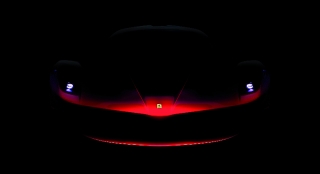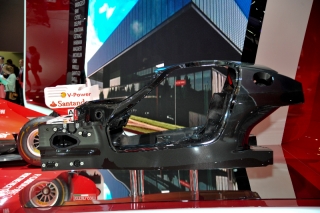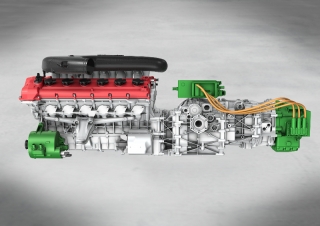First teaser images of the new Ferrari Special Limited Series supercar on Ferrari.com
Source: Ferrari
Maranello, 10 January 2013 – Now available on-line on the official Ferrari web site are the first teaser images of the new special limited series hybrid supercar which is due to debut later this year. The two images of the car accompany an interview by The Official Ferrari Magazine with Roberto Fedeli, Technical Director, and Flavio Manzoni, Head of the Styling Centre In the article they discuss the importance of the legacy of Ferrari’s previous special limited series models – the GTO, the F40, F50 and Enzo Ferrari – and the company’s approach today to transferring Formula 1 technology and innovations to its road cars.
Paris Motorshow 2012.
Ferrari showcases complete range of new-generation models at Paris
Source: Ferrari
World premiere for new F1 composite chassis for upcoming limited-edition special series
Paris, September 27th – The Ferrari display at the Paris Salon showcases the five cars making up the current range, each of which represents a new generation of the company’s 8- and 12-cylinder models.
The F12berlinetta is the most powerful and high-performance V12 ever built, thanks to its 740 hp power output and light, compact architecture. It is flanked by a model with a complementary mission, the FF, our revolutionary four-seater four-wheel-drive car which now sports a new full-length panoramic roof in a special reflective glass (LowE) that gives occupants a genuine open-air driving feeling, while providing thermal and acoustic insulation.
The coupé and the Spider versions of the 458, powered by the V8 that has won the Best Performance Engine Award for two consecutive years, are designed for owners seeking a sportier driving experience. The California 30 – the ‘30’ in the name referring to the reduction in weight and increase in horsepower introduced on the model earlier this year – is aimed at owners who put more store in greater versatility of use.
In line with its “Different Ferraris for different Ferraristi” philosophy, these cars are designed to fulfil complementary roles without compromising their DNA which remains absolutely unique in terms of performance, driving pleasure and advanced technologies. All offer exclusive design that combines modern styling with traditional cues typical of the marque.
Ferrari continually invests significant sums in its product range and this has led to the creation of 8- and 12-cylinder engines whose specific power outputs, levels of torque and maximum rev limits are unprecedented while, at the same time, offering improved fuel efficiency. Important innovations have led to reductions in the weight of our cars, too. In fact, the Scaglietti facility, which specialises in aluminium fabrication, works with more than 25 different alloys, some of which are being used for the first time in the automotive sector.
While power has been boosted by approximately 100 hp across the model range, fuel consumption and emissions have been reduced by 30 per cent compared to four years ago thanks to work done not only on our engines and structural components, but also on aerodynamics, tyres and vehicle sub-systems.
Ferrari continues to invest heavily in innovation and is planning to launch the first hybrid model in its history in the near future. Having already revealed the power unit’s architecture and components, Ferrari has chosen Paris to debut the new composite chassis derived directly from Formula 1 technologies.
Ferrari drew on its vast experience in working with composites for single-seaters for its new hybrid model which will be produced in a limited-edition, special series. For this model Ferrari chose not to use the industrial carbon-fibre manufacturing techniques, such as RTM (Resin Transfer Moulding), normally adopted in the automotive sector, as they did not meet the quality and functional standards Ferrari set itself.
The materials, design methodologies, construction processes, staff and instruments used are all shared with the Scuderia Ferrari, with the formation of a working group which relied on an important contribution from Rory Byrne, Ferrari’s F1 chief designer who was behind 11 of the team’s Championship titles.
The chassis uses four different types of carbon-fibre and is hand-laminated then cured in autoclaves following engineering processes which optimise the design by integrating the different components.
The main structure is made from T800 carbon with local, strategic applications of T800UD, a unidirectional carbon-fibre tape, for reinforcement. To ensure weight was kept to an absolute minimum, the structural underbody and the cross-member are made from another type of particularly high tensile strength carbon-fibre known as M46J. In certain critical areas, such as the doors, very tough T1000 was adopted as it is particularly efficient in terms of impact absorption which is why it is used in the nose-cone of the single-seaters. Carbon-fibre is combined with Kevlar® for the undertray to prevent damage from debris thrown up from the road.
The overall chassis is 20 per cent lighter than the Enzo Ferrari, despite the extra weight required by housing the hybrid components and to meet regulatory obligations. Torsional rigidity is increased by 27 per cent and beam stiffness is up by 22 per cent.
Success for Ferrari at Beijing Autoshow 2012.
Huge crowds on the stand to see the F12berlinetta and the HY-KERS
Source: Ferrari
Beijing, 23th April 2012 – After a hugely successful unveiling at Geneva, the F12berlinetta, the first in a new generation of Maranello’s flagship12-cylinder cars, makes its Asian debut at the Beijing International Motor Show. The event will also host the world premiere of the evolution of the HY-KERS concept, coupling hybrid technology with mid-rear architecture to cut fuel consumption and CO2 emissions on the combined cycle by 40 per cent whilst boosting performance.
The F12berlinetta is the most powerful and high-performance road-going Ferrari ever. Powered by a truly exceptional V12 engine, it is built around an evolution of Ferrari’s transaxle lay-out and features cutting-edge components and electronic controls. The F12berlinetta also boasts extremely advanced aerodynamics and a design that exudes an innovative yet classic beauty.
The car’s wheelbase is shorter, its engine and driver position are lower and a new suspension and gearbox layout has yielded a more compact tail section. The result is a shorter, lower and narrower car than the previous V12 coupé. It also boasts perfect weight distribution (54% over the rear axle) and a lower centre of gravity further back in the chassis.
With a Fiorano lap time of 1’23’’, 0-100 km/h acceleration in 3.1 seconds and 0-200 km/h covered in 8.5 s, the F12berlinetta delivers absolutely benchmark performance. The handling balance achieved ensures maximum driving involvement even at low speeds, a feature thus far the sole domain of mid-rear-engined cars. The sporty handling is equally nimble and responsive on the road as on the track.
Great attention was paid to reducing fuel consumption and emissions which have been slashed by 30 per cent, with the result that the F12berlinetta tops its segment in terms of efficiency with 15l/100 km and 350 g/km of CO2.
The other important unveiling at Beijing is the evolution of the HY-KERS project adapted to a mid-rear engine layout. The powertrain on display consists of a 12-cylinder engine and dual-clutch gearbox coupled to an electric motor. A second electric motor is dedicated to the auxiliary systems and is located in front of the V12. The two electric motors are connected to the batteries which can be positioned in the car in line with the available space and final configuration.
The objective of this configuration is to create a sports car that, thanks to the integration with the electric motors, increases power while at the same time reducing emissions. The KERS features new, smaller and lighter electronic components which come close to achieving the declared target of 1 KW per kg of extra weight added by the hybrid system.
Technological transfer from F1 was fundamental to the design, engineering and construction of an innovative electric motor used to optimise the car’s longitudinal and lateral dynamic characteristics, namely torque management, traction control and brake distribution, to the benefit of sportiness and driving pleasure.
The HY-KERS’ electric motor delivers power using one of the gearbox’s two clutches and is mated to one of the two main shafts. The result is instantaneous, continuous power delivery between the electric motor and petrol engine. During braking, the electric motor acts as a generator, using the kinetic energy from the negative torque to recharge the batteries. This crucial task is managed by a dedicated ECU, also F1-derived, which not only controls the electric motor, but also governs the power to the auxiliary systems (power steering, brake servo, air conditioning, onboard systems).
Work on the system has now reached the end of the experimental phase and the development phase will commence in the coming months. With the same nominal power output of a normal ICE, the HY-KERS system will enable Ferrari to reduce emissions by 40 per cent over the combined cycle.










